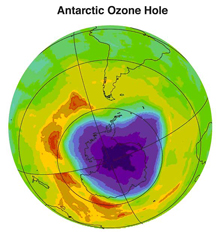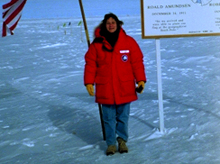The Ozone Hole at the Bottom of the World

The Antarctic ozone hole. In the stratosphere, the ozone layer plays a vital role in absorbing harmful ultraviolet radiation from the sun. Click image for larger view and full caption.
NOAA researchers seek to understand the different ways ozone affects human life. Most ozone is found in a layer more than six miles above the Earth. This stratospheric ozone layer prevents the sun's harmful, high-energy radiation from reaching the Earth. In contrast, ozone at the Earth’s surface is a pollutant that harms human health and reduces our quality of life.
When a hole appeared in the ozone layer over Antarctica in the 1980s, Dr. Susan Solomon and colleagues at the NOAA Aeronomy Laboratory (now the NOAA Chemical Sciences Division) wanted to know why. To solve the mystery, Solomon led two U.S. expeditions to the frozen continent in 1986 and 1987. Her teams' observations supported her hypothesis that chemical reactions of chlorine and icy clouds in the cold, polar stratosphere were responsible for ozone losses during the Antarctic springtime.

In 1986, NOAA scientist Dr. Susan Solomon and colleagues identified the cause of the Antarctic ozone hole, which is still celebrated as the most significant environmental success story of the 20th century.
As a result of Solomon’s findings, the Montreal Protocol on Substances that Deplete the Ozone Layer (the first treaty to address the Earth's environment) was enacted to phase out these compounds. The global production of ozone-depleting chlorofluorocarbons (CFCs) is now greatly reduced and there are signs that the ozone hole is slowly stepping into a recovery phase. In fact, both CFC and ozone levels are showing signs of leveling off and some CFCs have even started to decrease.
NOAA is responsible for monitoring the stratospheric ozone layer and ozone-depleting gases and plays a large role in making the fundamental measurements of other variables (water vapor, nitrous oxide, aerosols, etc.) that influence the ozone layer. NOAA scientists are leading efforts to assess alternative chemicals for possible use as replacements to ozone-depleting gases. NOAA is also synthesizing this information to get a comprehensive picture of the ozone layer, to understand how it is changing now and might change in the future.
NOAA has also led the effort to ensure the ozone recovery proceeds as expected. Measurements of ozone-depleting gases provide a means to measure compliance with international treaties, allowing NOAA to discern whether policy actions are having their desired effect.

Launch of an ozonesonde attached to a high-altitude balloon from the South Pole, Antarctica.
NOAA activities constitute a large part of the global scientific effort to understand stratospheric ozone depletion and recovery. NOAA scientists are not only involved in maintaining a large portion of the world’s air sampling and measurement network, but also provide the calibration necessary for an integrated network. They also serve on advisory groups and expert committees for assuring quality control, improving understanding, and identifying future needs. NOAA is guiding the recovery to assure that efforts are not sidetracked by unknown and unforeseen events or occurrences.
Through its meticulous monitoring of the atmospheric composition and scientific expertise, as well as the search for CFC alternatives, NOAA provides much of the global scientific foundation for understanding the ozone layer and its changes.
Works Consulted
NOAA’s Earth System Research Laboratory. Stratospheric Ozone Layer Depletion and Recovery. Retrieved on November 1, 2006, from: http://www.esrl.noaa.gov/research/themes/o3/.
Related Web Sites
Anniversary of the Discovery of the Cause of the Antarctic Ozone Hole
NOAA Satellite Images of the Ozone Hole
NOAA Research: The Ozone Layer
